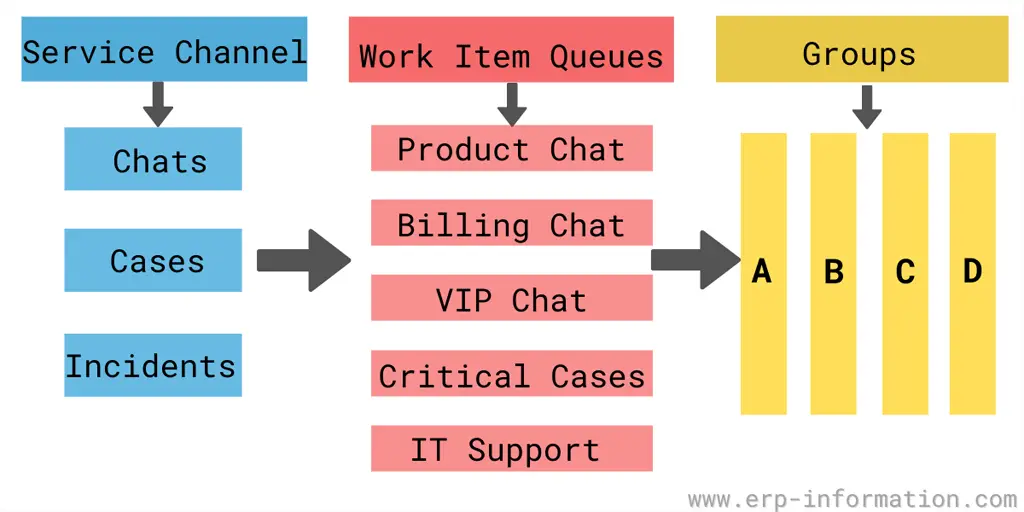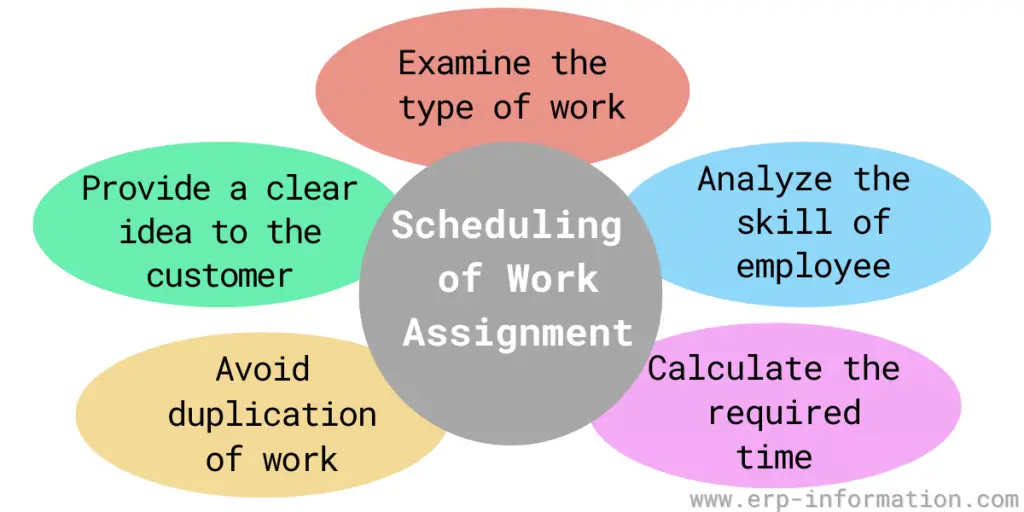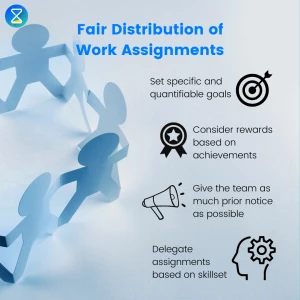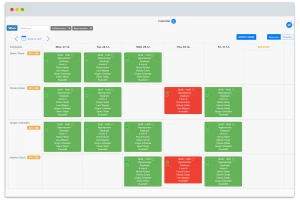What is Work Assignment? – Advanced Work Assignment (AWA)

Work assignment, a fundamental concept of professional realms, refers to allocating specific tasks or duties to individuals or teams within a certain timeframe.
These assignments, which can range from simple tasks to complex projects, serve as the backbone of productivity, facilitating the efficient functioning of an organization.
By clearly defining roles, responsibilities, and deadlines, work assignments ensure that each member is aware of their contribution towards the broader objectives.
This post will explain the work assignment, its scheduling, and its benefits. It will also discuss automated and advanced work assignments.

What is a Work Assignment?
A work assignment or job assignment refers to a task or set of tasks allocated to work centers , an individual, or a team within a specific timeframe. Depending on the context, it can be part of a larger project or an isolated task.
It helps distribute the workload evenly among team members, ensuring everyone knows their responsibilities and keeping track of progress toward goals.

Automated Work Assignment
Automated assignment of work helps to reduce the stress on employees. It saves the project manager time because the auto-assignment manager does not need to remind his team about the work. The system only gives notifications to the team.
Automated work assignment is when a computer system assigns work to employees based on predefined criteria in an automatic workflow. This can include skills required for the task, availability of employees, and other factors.
The use of automated work assignments can help to improve efficiency and accuracy within an organization.
Managers can efficiently assign work to minimize downtime and maximize productivity by considering employees’ individual skills and availability.
Automated systems can also help to ensure that tasks are appropriately distributed among employees, thus avoiding potential conflicts.
The advantage of the automatic assignment is it helps to deliver the project faster by avoiding confusion and rework because the task is assigned when all the requirements are entirely available.
Advanced Work Assignment
Advanced Work Assignment (AWA) is a methodology organizations use to create and assign work tasks to employees based on their skills, abilities, and interests.
This approach can help improve employee productivity and satisfaction while reducing organizational costs.
It can effectively engage employees in their work and maximize their potential when appropriately implemented.
One of the critical benefits of it is that it allows organizations to optimize their resources and assign work that is most suited to each employee’s skills, abilities, and interests.
This helps improve productivity by ensuring employees are matched with tasks they can complete while fostering engagement and satisfaction.
Additionally, it can help reduce organizational costs by ensuring that employees are assigned work within their abilities and do not require excessive training or support.
Despite these benefits, some potential challenges are associated with using AWA.
For example, employees may sometimes resist or feel uncomfortable with being assigned work outside their comfort zone or feel they are not allowed to develop new skills.
Additionally, accurately assessing each employee’s skills and interests can be challenging, leading to some employees being assigned work that is not well-suited.
Therefore, it is essential to carefully consider whether or not AWA is right for your organization before implementing it.
When appropriately used, Advanced Work Assignments can effectively improve employee productivity and satisfaction while reducing organizational costs.
Scheduling of Work Assignment
When you are using a computerized system to schedule work, it is essential to know that some factors affect employees’ performance before uploading the names of employees in the system.
This includes understanding how these applications operate and considering what kind of factor affects them most when deciding which option will be best suited for your business needs!
You can utilize manual assignment or auto-assignment for scheduling once you get it.
The following are some tips for scheduling the assignment.

1. Examine the type of work
It is crucial to find out the type of work. For example, some work has to be done in one department. However, some work must be divided between the different departments, and those departments must develop internal work procedures.
2. Analyze the skills of the employees
Each employee has their talent. So before scheduling the work, making one flowchart of the work process is better.
After analyzing employees’ skills, assign the work in the flowchart to the specified employees. Also, keep one backup person if the designated employee cannot perform the job.
3. Calculate the required time
Go through the flowchart and calculate the time required for each stage of the work or project to streamline the work process and complete the job efficiently.
4. Avoid the duplication of work
When you assign laborers to different fundamental processes, there will be a chance of duplicating work because all the laborers do jobs not mentioned in the flow chart.
Hence, carefully check the workflow across the organization and ensure there is no work duplication.
5. Provide a clear idea to the customer
Provide a clear idea to the customer about communication. That means informing him clearly to whom he should communicate to get information about the project and assigning a specified person.
Considering customers’ expectations is critical to set company standards. It helps to learn the market standards also. It will be achievable when you do a proper work assignment.
Important Information that Works Assignment Contains
Work assignment contains mainly these four essential pieces of information. They are
- Which task is to be done : Clearly explain to the employees which task to be taken based on priority.
- The reason for doing that task : When you assign new work to the employees before completing current work, you need to explain its reason.
- What standards should completed tasks meet: Let employees know about the evaluation of the completed job.
- All-motive directions: This means telling the employees to inform their managers about the completed task and the problems they face while doing the tasks.
Benefits of work assignment
- It is easy to track who is responsible for which work.
- It contains some information like which task to be done as per the priority, what must be the standards of the completed task, etc. It helps the assigned person to do the job efficiently.
- By assigning work to a particular team or a person, they know which work to do as per the priority and do that work efficiently to increase customer satisfaction.
What are the components of Advanced Work Assignment (AWA)?
The components of Advanced Work Assignment (AWA) are: -Work Instructional Package (WIP) -Task Guide -Performers Instructions -Standard Operating Procedure (SOP) -Work Area Layout diagram.
What is Standard Operating Procedure (SOP)?
Standard Operating Procedure (SOP) , often shortened to “the SOP,” is a standardized plan adopted by an organization for the orderly and efficient carrying out of various activities such as work, production, or services.
The SOP is a company-wide standard that includes everything from greeting coworkers in the morning to what to do if there’s a fire.
While it may appear overly restrictive at times, its goal is to minimize variation and mistakes. Every business activity has at least one best practice that can lead to success and efficiency if adhered to deliberately and consistently.
What is a Work Instructional Package (WIP)?
A Work Instructional Package (WIP) is a document that provides step-by-step instructions for performing a specific job or task. It may also include diagrams, photographs, and illustrations to help clarify the steps involved.
WIPs are generally used in manufacturing and production settings but can also be helpful in other types of workplaces.
For example, if you work in an office and need to learn how to use a new software program, your company might provide a WIP outlining the steps to install and configure the software.
The proliferation of technology has led to an increased demand for automation. Companies have found a balance between humans and machines using automated work assignment software, or AWA. Automatic job assignments can be used in many industries, from IT support to sales call centers.
Related Articles
- What is Corporate Performance Management (CPM / EPM / BPM)?
- What is Project Management? (Steps, Methodologies, and Challenges)
- Phases of SDLC (Benefits, Models, and Best Practices)
- What is Human Resource? (Human Resource Management and Analytics)
- What is Agile SDLC? (Phases, Methodologies, and Disadvantages)
- What is Aggregate Planning? - Strategies, Types & Examples
- What is Work Center? (Scheduling, Calculation, Structure)

Tips for Allocating Work Assignments

It’s probably a no-brainer that improper delegation of tasks has obvious consequences, such as increased frustration, stress and workload. The quality of work and team morale may suffer while trust, productivity, efficiency and profitability dwindles. In such a situation, the organizational structure fails, clients’ trust dies, reports of unaccountability emerge, staff may underperform and project failure becomes imminent. This is why it’s vital to ensure that work assignments are delegated efficiently and to the appropriate team member.
Approximately 94% of companies lack exceptionally good management. The 6% of firms with excellent management culture and style tend to be dedicated to their workforce and team building rather than external stakeholders.
Achieving excellence in organizational operations is an enormous challenge for most organizations and begins with the manner and style of delegation of assignments.
Management has to choose the right team , build trust and accountability , develop its team through delegation, manage performances, have tough conversations and acknowledge and reward excellence to enhance employee engagement and lower turnover.
What exactly are work assignments?
Work assignments are remarkable tools for enhancing employee growth and must be managed deliberately; otherwise, they could limit efforts towards building a diverse workforce.
Evidence shows that experimental learning accounts for 70% of leadership development , particularly, effective delegation of work assignments.
Work assignments are tasks that are deliberately designed for organizational purposes. They are allocated to staff to achieve results. In the simplest terms, these assignments are activities or projects for a specific end. Work assignments should come with a task description, deadline and expected results.

Work assignments tips
Why delegate work assignments?
Employee empowerment.
Managers with great team building skills understand the importance of instilling trust in team members for enhanced morale and performance because they believe they are wired to drive organizational objectives.
Strengthens trust
Assigning work means trusting the employee’s ability to achieve a particular result through task performance. Frequent delegation builds the trust needed to create collaborative skills within organizations.
Helps lower workload
Successful delegation of work assignments lessens the burden of tasks that pile up. It saves the time needed to focus on other important organizational tasks and goals.
Planning for fair distribution of work assignments
Most industries, such as hospitality, telecommunications and healthcare need to ensure uninterrupted service delivery. At the same time, they must consider the health of their employees, who need regular breaks and leave to stay productive and rested.
With the rise of flexi-workers , ensuring everyone gets a fair share of leave could become a logistics nightmare for business owners. This also applies to contractual staff who may feel overburdened.
When planning and distributing work assignments, managers must take into account employees’ vacation days, sick leave, emergency absences and so on. Things to consider include, but are not limited to:
- Employees should have their preferences fulfilled to avoid bias.
- Organizations should try to accommodate employees’ requests for rest days as much as possible.
- The duty roster should be planned in such a way as to allow enough time for deadlines and urgent tasks.
- There is also an allowance for fair leave/day swapping among employees.
The manager planning the duty roster should keep track of requests and demands in real time. This enables the planner to synchronize replacement leave and overtime pay calculations at the end of the roster period.
Delegating work assignments to employees
Create an effective work plan.
An effective work plan is the key to the success of every project. Approximately 58% of organisations don’t understand the value of project management, which explains why most projects fail as soon as they begin.
The planning phase determines either the failure or success of such project. Organizations must have a solid work plan, including a weekly action plan for greater efficiency and productivity. You can create a good work plan by following the steps below.
- Set specific goals that include actual numbers and quantifiable terms and scope.
- Lay out the objectives and deliverables, including the project schedule. Consider rewarding your team based on achievement. The incentives will boost productivity.
- Brainstorm and detail the key resources that your team needs. Brainstorming and planning will help colleagues become creative, forecast unforeseen obstacles and promote teamwork. Converse with your them about the resources that can help them achieve set objectives and give them available resources.
- Identify task sequencing . The schedule of a project outlines activity sequencing, tracks performance and calculates the duration of tasks sequences.
Delegate assignments based on aptitude
By assigning work to employees based on their areas of strength and skills, you set them up to excel. This means you need to understand your employees’ strengths, preferences and weaknesses. You may also allow your staff to choose their preferred tasks. This is important for building trust.
Give your team prior notice
No need to stress everyone out and kill their morale with endless impromptu and urgent work assignments. As far as is feasible, try to give your employees a couple of days’ notice at least.
Foster project ownership
Encourage your team to ask questions for clarity. Determine your availability and take the time to give them clear instructions, feedback and assistance. Giving them a sense of ownership allows your team members to see the big picture.
Real delegation is when you encourage your team to own the project. This gives them the authority to take initiative for the execution process.
Most companies spend hours and weeks planning and generating roasters manually when they can use TimeTrack Duty Roster to save time. TimeTrack Duty Roster creates a perfect overview of both employers and employees and allow managers to personalize shifts according to preferences.

TimeTrack Duty Roster

Monitoring work assignments
Monitoring work assignments helps your team complete their duties successfully and meet the desired outcomes. There’s no need to micromanage, but you can certainly help keep employees focused while tracking processes.
Ensure an effective project plan
- Compile a clear project outline, including a schedule. Collaborate with your team to create the plan and include the project scope, tasks, deadlines and resources. Creating a timeline is vital; use a flow chart to make things clearer. A clear work plan helps you understand the key performance indicators you can monitor.
Set SMART goals
- One of the key ways to monitor assigned work is to create specific, measurable, attainable, relevant and time-bound goals. This SMART criteria helps you identify detailed and quantifiable goals with effective deadlines. You then have quantifiable items to monitor the performance of the assignments.
Steady check-ins
- Creating a schedule for progress check-ins is a key step in monitoring assignments. The regularity of the check-in depends on the project. For example, check-ins for long-term and short-term projects differ in intervals. Check-ins should be balanced to support effective monitoring of performance indicators.
Records and analysis of data
- For each of the scheduled check-ins, keep records and analyze data to understand the progress of projects. You can gather data through team meetings and input into spreadsheets or project management tools. The data will then be analyzed to determine the status of the assigned work.
Every organization wants to empower its workforce for enhanced morale, focus, accountability, efficiency and productivity. These achievements are only possible with effective delegation of work assignments and tasks.

I am a researcher, writer, and self-published author. Over the last 9 years, I have dedicated my time to delivering unique content to startups and non-governmental organizations and have covered several topics, including wellness, technology, and entrepreneurship. I am now passionate about how time efficiency affects productivity, business performance, and profitability.
Time Tracking
- Absence Management Software
- Clock In System
- Time Attendance System
- Auto Scheduling
- Duty Roster
- Shift Planning
- Appointment Planning
- Task Planning
- Integrations
- Info Center
- Timesheet Templates
- Download Apps
- Rota Templates
- Promotional Program
- Affiliate Program
- Success Stories

Assignment vs. Delegation
What's the difference.
Assignment and delegation are two different ways of distributing tasks and responsibilities within a group or organization. Assignment refers to the act of allocating specific tasks or projects to individuals or teams based on their skills, expertise, or availability. It involves providing clear instructions and expectations to the assigned person, who then becomes solely responsible for completing the task. On the other hand, delegation involves entrusting someone with the authority to make decisions and take actions on behalf of the delegator. It involves not only assigning tasks but also granting the necessary power and autonomy to the delegatee to accomplish the assigned tasks. While assignment focuses on task distribution, delegation emphasizes the transfer of authority and decision-making power.
Further Detail
Introduction.
When it comes to managing tasks and responsibilities, two common approaches are assignment and delegation. Both methods involve distributing work among individuals or teams, but they differ in terms of authority, control, and accountability. In this article, we will explore the attributes of assignment and delegation, highlighting their key differences and benefits.
Assignment refers to the act of allocating specific tasks or projects to individuals or teams. It involves providing clear instructions, setting deadlines, and defining the expected outcomes. Assignments are typically made by a person in a position of authority, such as a manager or supervisor, who has the power to distribute work among subordinates.
One of the key attributes of assignment is the level of control it offers to the assignor. By assigning tasks, the assignor retains a significant degree of authority over the process and outcome. They have the power to dictate how the work should be done, provide guidance, and make decisions along the way. This level of control can be beneficial in situations where strict adherence to guidelines or standards is crucial.
Another attribute of assignment is the clear accountability it establishes. When tasks are assigned, the assignee becomes responsible for completing them within the given timeframe and meeting the specified requirements. This accountability ensures that individuals are held responsible for their work and can be evaluated based on their performance.
Furthermore, assignment allows for a structured approach to task distribution. The assignor can carefully assess the skills, capabilities, and workload of each individual or team before making assignments. This enables a more efficient allocation of resources and ensures that tasks are assigned to the most suitable individuals or teams.
However, assignment also has its limitations. The assignor may become overwhelmed with the responsibility of distributing tasks and overseeing their progress. This can lead to micromanagement and a lack of autonomy for the assignees. Additionally, if the assignor is unavailable or lacks the necessary expertise, it may result in suboptimal task allocation.
Delegation, on the other hand, involves entrusting a task or responsibility to another person or team while retaining overall accountability. It is a process that empowers individuals or teams to make decisions, take ownership, and exercise their judgment in completing the delegated tasks.
One of the key attributes of delegation is the level of autonomy it provides to the delegatee. Unlike assignment, delegation allows individuals or teams to have more control over the process and decision-making. They are given the authority to determine how the task should be accomplished, which can foster creativity, innovation, and a sense of ownership.
Another attribute of delegation is the opportunity for skill development and growth. By delegating tasks, the delegator can empower individuals or teams to take on new challenges, learn new skills, and expand their capabilities. This not only benefits the delegatee but also helps in building a more versatile and resilient workforce.
Furthermore, delegation can enhance collaboration and teamwork. When tasks are delegated, it encourages individuals or teams to work together, share knowledge, and support each other in achieving the common goal. This collaborative approach can lead to improved communication, increased efficiency, and a stronger sense of camaraderie.
However, delegation also comes with its own set of challenges. The delegator needs to carefully select the right individuals or teams to delegate tasks to, considering their skills, experience, and availability. Inadequate delegation can result in tasks being mishandled or not completed to the desired standard. Additionally, the delegator needs to strike a balance between providing guidance and support while allowing the delegatee to exercise their autonomy.
Now that we have explored the attributes of assignment and delegation, let's compare them to understand their differences more clearly.
Authority and Control
Assignment provides a higher level of authority and control to the assignor. They have the power to dictate how the work should be done and make decisions along the way. In contrast, delegation empowers the delegatee with more autonomy and decision-making authority, allowing them to determine the best approach to completing the task.
Accountability
Both assignment and delegation establish accountability, but in different ways. In assignment, the assignee is directly responsible for completing the task within the given timeframe and meeting the specified requirements. In delegation, while the delegatee is responsible for the task's execution, the delegator retains overall accountability for the outcome.
Task Allocation
Assignment follows a structured approach to task distribution, where the assignor assesses the skills and workload of individuals or teams before making assignments. Delegation, on the other hand, requires the delegator to carefully select the right individuals or teams based on their skills, experience, and availability.
Level of Autonomy
Assignment limits the autonomy of the assignee, as they are expected to follow the instructions and guidelines provided by the assignor. In contrast, delegation grants a higher level of autonomy to the delegatee, allowing them to exercise their judgment, make decisions, and determine the best course of action.
Development and Growth
While assignment focuses on task completion, delegation provides an opportunity for skill development and growth. By delegating tasks, the delegator empowers individuals or teams to take on new challenges, learn new skills, and expand their capabilities.
Collaboration and Teamwork
Assignment primarily focuses on individual tasks, whereas delegation encourages collaboration and teamwork. Delegated tasks often require individuals or teams to work together, share knowledge, and support each other in achieving the common goal.
Assignment and delegation are two distinct approaches to task distribution, each with its own attributes and benefits. Assignment provides control, clear accountability, and a structured approach to task allocation. On the other hand, delegation empowers individuals or teams with autonomy, fosters skill development, and enhances collaboration. The choice between assignment and delegation depends on the nature of the task, the level of control desired, and the development opportunities sought. By understanding the attributes of assignment and delegation, managers and leaders can make informed decisions to optimize task distribution and achieve organizational goals.
Comparisons may contain inaccurate information about people, places, or facts. Please report any issues.
- More from M-W
- To save this word, you'll need to log in. Log In
Definition of assignment
task , duty , job , chore , stint , assignment mean a piece of work to be done.
task implies work imposed by a person in authority or an employer or by circumstance.
duty implies an obligation to perform or responsibility for performance.
job applies to a piece of work voluntarily performed; it may sometimes suggest difficulty or importance.
chore implies a minor routine activity necessary for maintaining a household or farm.
stint implies a carefully allotted or measured quantity of assigned work or service.
assignment implies a definite limited task assigned by one in authority.
Examples of assignment in a Sentence
Word history.
see assign entry 1
14th century, in the meaning defined at sense 1
Phrases Containing assignment
- self - assignment
Dictionary Entries Near assignment
Cite this entry.
“Assignment.” Merriam-Webster.com Dictionary , Merriam-Webster, https://www.merriam-webster.com/dictionary/assignment. Accessed 13 Nov. 2024.
Legal Definition
Legal definition of assignment, more from merriam-webster on assignment.
Nglish: Translation of assignment for Spanish Speakers
Britannica English: Translation of assignment for Arabic Speakers
Subscribe to America's largest dictionary and get thousands more definitions and advanced search—ad free!

Can you solve 4 words at once?
Word of the day.
See Definitions and Examples »
Get Word of the Day daily email!
Popular in Grammar & Usage
How to use em dashes (—), en dashes (–) , and hyphens (-), plural and possessive names: a guide, the difference between 'i.e.' and 'e.g.', why is '-ed' sometimes pronounced at the end of a word, what's the difference between 'fascism' and 'socialism', popular in wordplay, 8 words with fascinating histories, 8 words for lesser-known musical instruments, birds say the darndest things, 10 words from taylor swift songs (merriam's version), 10 scrabble words without any vowels, games & quizzes.

- Cambridge Dictionary +Plus
Meaning of assignment in English
Your browser doesn't support HTML5 audio
- It was a jammy assignment - more of a holiday really.
- He took this award-winning photograph while on assignment in the Middle East .
- His two-year assignment to the Mexico office starts in September .
- She first visited Norway on assignment for the winter Olympics ten years ago.
- He fell in love with the area after being there on assignment for National Geographic in the 1950s.
- act as something phrasal verb
- all work and no play (makes Jack a dull boy) idiom
- be at work idiom
- be in work idiom
- housekeeping
- in the line of duty idiom
- undertaking
You can also find related words, phrases, and synonyms in the topics:
assignment | American Dictionary
Assignment | business english, examples of assignment, collocations with assignment.
These are words often used in combination with assignment .
Click on a collocation to see more examples of it.
Translations of assignment
Get a quick, free translation!

Word of the Day
be between girlfriends/ boyfriends
to no longer have a job, marriage, boyfriend, girlfriend, etc. at the present time, but expect or be likely to get another one

Nobody blames you: phrases for offering reassurance

Learn more with +Plus
- Recent and Recommended {{#preferredDictionaries}} {{name}} {{/preferredDictionaries}}
- Definitions Clear explanations of natural written and spoken English English Learner’s Dictionary Essential British English Essential American English
- Grammar and thesaurus Usage explanations of natural written and spoken English Grammar Thesaurus
- Pronunciation British and American pronunciations with audio English Pronunciation
- English–Chinese (Simplified) Chinese (Simplified)–English
- English–Chinese (Traditional) Chinese (Traditional)–English
- English–Dutch Dutch–English
- English–French French–English
- English–German German–English
- English–Indonesian Indonesian–English
- English–Italian Italian–English
- English–Japanese Japanese–English
- English–Norwegian Norwegian–English
- English–Polish Polish–English
- English–Portuguese Portuguese–English
- English–Spanish Spanish–English
- English–Swedish Swedish–English
- Dictionary +Plus Word Lists
- on assignment
- American Noun
- Collocations
- Translations
- All translations
To add assignment to a word list please sign up or log in.
Add assignment to one of your lists below, or create a new one.
{{message}}
Something went wrong.
There was a problem sending your report.

IMAGES
VIDEO
COMMENTS
Advanced Work Assignment (AWA) is a methodology organizations use to create and assign work tasks to employees based on their skills, abilities, and interests. This approach can help improve employee productivity and satisfaction while reducing organizational costs.
What Every Job Seeker Should Know About Work Assignments During the Interview Process. You’re progressing well through an interview process, and you think you’re close to landing that coveted offer, when the employer says, “One more thing—we have a little homework for you.”.
Companies usually ask for work assignments during the interview process if they are interested in you as a potential candidate and want to see what kind of work you can do. Seeing examples of your work helps employers evaluate your talent and skills beyond what your resume states.
Work assignments are tasks that are deliberately designed for organizational purposes. They are allocated to staff to achieve results. In the simplest terms, these assignments are activities or projects for a specific end.
Work Assignment. Means a position or post calling for specified duties to which an employee is assigned for a definite or indefinite period of time but which has not been designated as a work classification. Duty assignment is interchangeable with work assignment.
Assignment provides control, clear accountability, and a structured approach to task allocation. On the other hand, delegation empowers individuals or teams with autonomy, fosters skill development, and enhances collaboration.
A work assignment is used as a work instruction, service instruction or as a trigger for projects. The form, scope and meaning vary.
Section 1. The Employer will assign work in accordance with applicable laws, rules, and regulations and the Employer's needs and operational goals. Section 2. Work assignments will be consistent with an employee's position description, and if the Employer assigns other work, it normally shall have a reasonable relationship to the employee's ...
1. : the act of assigning something. the assignment of a task. 2. a. : a position, post, or office to which one is assigned. Her assignment was to the embassy in India. b. : a specified task or amount of work assigned or undertaken as if assigned by authority. a homework assignment. 3. law : the transfer of property.
a piece of work given to someone, typically as part of their studies or job: a freelance / photo assignment. I have a lot of reading assignments to complete before the end of term. [ C ] a job that someone is sent somewhere to do: a foreign / diplomatic assignment. on assignment.